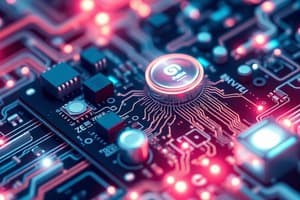Podcast
Questions and Answers
What is the unit of measurement for voltage?
What is the unit of measurement for voltage?
Volts
Define current in terms of electric charge movement.
Define current in terms of electric charge movement.
Amount of electric charge moving past a point per unit time
Explain the relationship between resistance and current flow.
Explain the relationship between resistance and current flow.
Higher resistance results in lower current flow, assuming voltage is constant.
What law is expressed by the equation V = IR?
What law is expressed by the equation V = IR?
How do voltage changes affect the flow of electric current?
How do voltage changes affect the flow of electric current?
What is electric current?
What is electric current?
How do resistors affect the flow of charge in a circuit?
How do resistors affect the flow of charge in a circuit?
Explain the role of conductors in electricity.
Explain the role of conductors in electricity.
What is the relationship between voltage, current, and resistance in a circuit?
What is the relationship between voltage, current, and resistance in a circuit?
How are circuits defined in the context of electricity?
How are circuits defined in the context of electricity?
What drives the movement of charged particles in an electric circuit?
What drives the movement of charged particles in an electric circuit?
Study Notes
Electricity: Understanding Its Components and Principles
In our daily lives, electricity is a hidden force shaping our world—from powering your laptop to illuminating street lights. Let's peel back the layers of this phenomenal energy source by exploring its fundamental concepts.
Electric Currents
Electric current refers to the flow of charged particles known as electrons through a conductor. These charges move due to electrical potential differences, driven by forces such as batteries or generators.
Resistors
Resistors play the role of controlling the rate at which charge flows through a circuit. They impede the movement of electrons by offering some level of opposition against their motion. In other words, they restrict the electric current flowing through them according to Ohm’s Law ((V=IR)), where (V) represents voltage across the component, (I) signifies the resulting electric current, and (R) symbolizes the value of the resistor itself.
Conductors
Conductors facilitate the passage of electric current; materials like copper, aluminum, and silver excel at conducting electricity because they have free electrons available to move when subjected to an applied voltage.
Circuits
Circuits shape electrical connections between components and devices while guiding electric current along defined paths. As current enters a closed path via a source, it encounters various elements before ultimately returning to the starting point, ensuring continuity throughout the loop.
Voltage, Current, and Resistance
Understanding these three interrelated principles will help you decode electricity's mysteries with ease.
- Voltage: Measured in volts, voltage describes the pressure driving electric current through a wire or device. When voltage increases between two points, more electric current can flow between those points.
- Current: Expressed in amperes, current quantifies how much electric charge moves past a given point per unit time. Greater current means faster flow.
- Resistance: Resistance characterizes how difficult it is for electric current to pass through a material. Higher resistance results in lower current, assuming voltage remains constant.
The relationship among these variables is eloquently described by Ohm's law ((V = IR)) and Joule's law ((P = I^2 \times R)). Note that P stands for Power, which is expressed in watts. This knowledge equips us to comprehend the basic operations inherent within any system powered by electricity.
Mastery of these basics opens doors into understanding countless realms of technology, from appliances to electronics, renewable systems to smart grids. By learning about electricity's essential components and properties, we empower ourselves to engage with modern society meaningfully and confidently.
Studying That Suits You
Use AI to generate personalized quizzes and flashcards to suit your learning preferences.
Description
Uncover the foundational concepts of electricity, from electric currents and resistors to conductors and circuits. Dive into the relationship between voltage, current, and resistance, as well as the implications of Ohm's Law and Joule's Law in understanding electrical systems.




